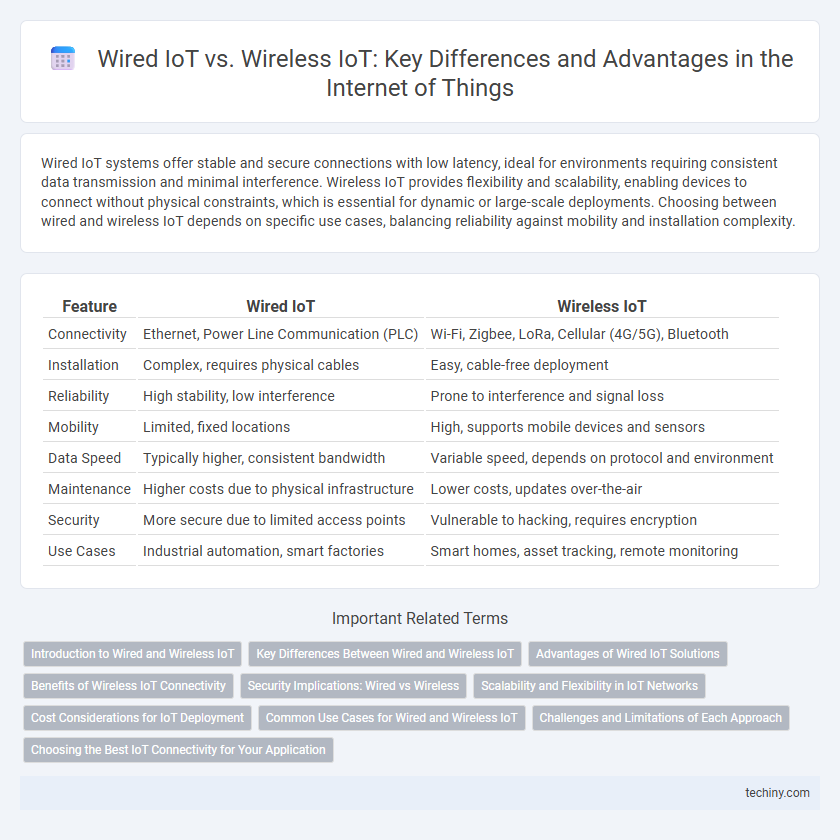Wired IoT systems offer stable and secure connections with low latency, ideal for environments requiring consistent data transmission and minimal interference. Wireless IoT provides flexibility and scalability, enabling devices to connect without physical constraints, which is essential for dynamic or large-scale deployments. Choosing between wired and wireless IoT depends on specific use cases, balancing reliability against mobility and installation complexity.
Table of Comparison
| Feature | Wired IoT | Wireless IoT |
|---|---|---|
| Connectivity | Ethernet, Power Line Communication (PLC) | Wi-Fi, Zigbee, LoRa, Cellular (4G/5G), Bluetooth |
| Installation | Complex, requires physical cables | Easy, cable-free deployment |
| Reliability | High stability, low interference | Prone to interference and signal loss |
| Mobility | Limited, fixed locations | High, supports mobile devices and sensors |
| Data Speed | Typically higher, consistent bandwidth | Variable speed, depends on protocol and environment |
| Maintenance | Higher costs due to physical infrastructure | Lower costs, updates over-the-air |
| Security | More secure due to limited access points | Vulnerable to hacking, requires encryption |
| Use Cases | Industrial automation, smart factories | Smart homes, asset tracking, remote monitoring |
Introduction to Wired and Wireless IoT
Wired IoT utilizes physical cables like Ethernet and fiber optics to ensure stable, high-speed connections crucial for industrial and large-scale deployments, offering enhanced security and minimal latency. Wireless IoT relies on technologies such as Wi-Fi, Bluetooth, Zigbee, and cellular networks, providing flexibility and ease of installation for diverse applications including smart homes and wearable devices. Both wired and wireless IoT systems play critical roles in the expanding ecosystem, balancing connectivity requirements with deployment environments and operational constraints.
Key Differences Between Wired and Wireless IoT
Wired IoT systems provide stable and secure connections through physical cables, ensuring low latency and high data transfer rates, ideal for industrial applications requiring reliability. Wireless IoT offers flexibility and ease of deployment with technologies like Wi-Fi, Bluetooth, and LoRa, supporting mobility and broader device integration but may face interference and security challenges. Power consumption and infrastructure costs also vary significantly, with wired IoT demanding installation effort, whereas wireless IoT optimizes scalability and remote monitoring capabilities.
Advantages of Wired IoT Solutions
Wired IoT solutions offer superior reliability and stable data transmission by eliminating interference common in wireless networks, making them ideal for critical industrial applications. These systems provide enhanced security due to physical cable connections, reducing vulnerability to cyberattacks compared to wireless counterparts. Additionally, wired networks support higher data throughput and consistent power supply, ensuring uninterrupted operation of IoT devices in demanding environments.
Benefits of Wireless IoT Connectivity
Wireless IoT connectivity offers enhanced flexibility and scalability, enabling devices to be easily relocated or added without the constraints of physical wiring. It reduces installation and maintenance costs by eliminating the need for cables and connectors, facilitating faster deployment in diverse environments. Wireless solutions support real-time data transmission and remote monitoring, improving operational efficiency and enabling seamless integration with cloud platforms.
Security Implications: Wired vs Wireless
Wired IoT networks offer enhanced security due to their physical connections, reducing the risk of unauthorized access and signal interception compared to wireless IoT systems. Wireless IoT devices, relying on wireless transmission protocols such as Wi-Fi, Zigbee, and Bluetooth, face increased vulnerabilities from cyberattacks like eavesdropping, man-in-the-middle attacks, and signal jamming. Implementing robust encryption standards and secure authentication mechanisms is critical to mitigating the security challenges inherent in wireless IoT deployments.
Scalability and Flexibility in IoT Networks
Wired IoT networks offer robust scalability through stable, high-bandwidth connections but lack the flexibility required for dynamic deployment across diverse environments. Wireless IoT networks excel in flexibility, enabling rapid expansion and adaptation without physical constraints, though scalability can be challenged by spectrum limitations and interference. Optimal IoT solutions balance wired reliability with wireless agility to meet specific scalability and flexibility demands in industrial and consumer applications.
Cost Considerations for IoT Deployment
Wired IoT deployments typically incur higher initial infrastructure costs due to physical cabling and installation labor, especially in complex or large-scale environments. Wireless IoT solutions often reduce deployment expenses by eliminating the need for extensive wiring, though ongoing costs may include battery replacements and potential signal interference mitigation. Evaluating total cost of ownership requires balancing upfront setup costs against long-term maintenance and scalability needs for each IoT deployment scenario.
Common Use Cases for Wired and Wireless IoT
Wired IoT systems are commonly used in industrial automation, smart factories, and data centers where reliable, high-speed data transmission and enhanced security are critical. Wireless IoT devices dominate smart home applications, agriculture monitoring, and asset tracking due to their flexibility, ease of deployment, and broad coverage. Industries often combine both wired and wireless IoT to optimize network performance, security, and scalability.
Challenges and Limitations of Each Approach
Wired IoT systems face challenges such as limited scalability and higher installation costs due to physical cabling requirements, restricting flexibility in dynamic environments. Wireless IoT encounters issues including signal interference, limited range, and security vulnerabilities, which can impact data reliability and network integrity. Both approaches must address power consumption constraints and maintenance complexities to ensure efficient and resilient IoT deployments.
Choosing the Best IoT Connectivity for Your Application
Wired IoT connectivity offers reliable data transmission with minimal interference, ideal for applications requiring consistent performance and security, such as industrial automation and smart grids. Wireless IoT provides flexibility and scalability, supporting mobility and ease of installation in environments like smart homes and wearable devices. Selecting the best IoT connectivity depends on factors such as range, power consumption, latency, and environmental conditions related to the specific use case.
Wired IoT vs Wireless IoT Infographic

 techiny.com
techiny.com